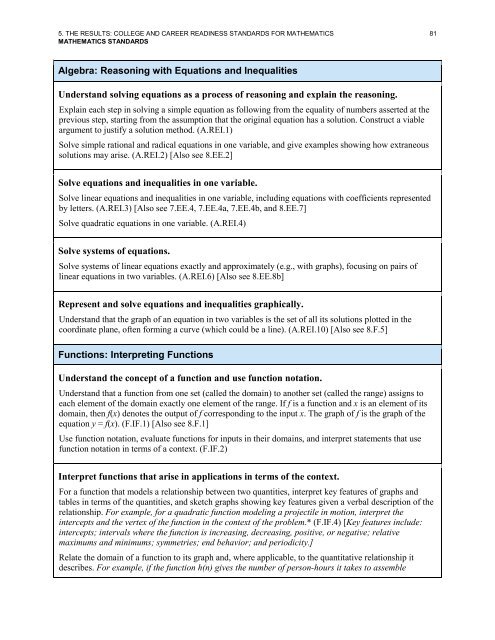CCRStandardsAdultEd
Create successful ePaper yourself
Turn your PDF publications into a flip-book with our unique Google optimized e-Paper software.
5. THE RESULTS: COLLEGE AND CAREER READINESS STANDARDS FOR MATHEMATICS 81<br />
MATHEMATICS STANDARDS<br />
Algebra: Reasoning with Equations and Inequalities<br />
Understand solving equations as a process of reasoning and explain the reasoning.<br />
Explain each step in solving a simple equation as following from the equality of numbers asserted at the<br />
previous step, starting from the assumption that the original equation has a solution. Construct a viable<br />
argument to justify a solution method. (A.REI.1)<br />
Solve simple rational and radical equations in one variable, and give examples showing how extraneous<br />
solutions may arise. (A.REI.2) [Also see 8.EE.2]<br />
Solve equations and inequalities in one variable.<br />
Solve linear equations and inequalities in one variable, including equations with coefficients represented<br />
by letters. (A.REI.3) [Also see 7.EE.4, 7.EE.4a, 7.EE.4b, and 8.EE.7]<br />
Solve quadratic equations in one variable. (A.REI.4)<br />
Solve systems of equations.<br />
Solve systems of linear equations exactly and approximately (e.g., with graphs), focusing on pairs of<br />
linear equations in two variables. (A.REI.6) [Also see 8.EE.8b]<br />
Represent and solve equations and inequalities graphically.<br />
Understand that the graph of an equation in two variables is the set of all its solutions plotted in the<br />
coordinate plane, often forming a curve (which could be a line). (A.REI.10) [Also see 8.F.5]<br />
Functions: Interpreting Functions<br />
Understand the concept of a function and use function notation.<br />
Understand that a function from one set (called the domain) to another set (called the range) assigns to<br />
each element of the domain exactly one element of the range. If f is a function and x is an element of its<br />
domain, then f(x) denotes the output of f corresponding to the input x. The graph of f is the graph of the<br />
equation y = f(x). (F.IF.1) [Also see 8.F.1]<br />
Use function notation, evaluate functions for inputs in their domains, and interpret statements that use<br />
function notation in terms of a context. (F.IF.2)<br />
Interpret functions that arise in applications in terms of the context.<br />
For a function that models a relationship between two quantities, interpret key features of graphs and<br />
tables in terms of the quantities, and sketch graphs showing key features given a verbal description of the<br />
relationship. For example, for a quadratic function modeling a projectile in motion, interpret the<br />
intercepts and the vertex of the function in the context of the problem.* (F.IF.4) [Key features include:<br />
intercepts; intervals where the function is increasing, decreasing, positive, or negative; relative<br />
maximums and minimums; symmetries; end behavior; and periodicity.]<br />
Relate the domain of a function to its graph and, where applicable, to the quantitative relationship it<br />
describes. For example, if the function h(n) gives the number of person-hours it takes to assemble


